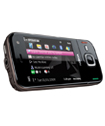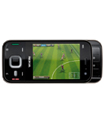Nokia N85 has been touted as the light version of the N96, with similar features but more affordable. In a long list of N-series releases, the N85 doesn't really stand out since it has no real new innovation. The features are good in their own way, but there is nothing about the phone that is truly startling.
Look, Design, Feel (/10)

The first impression of the phone is that it is bulky. The front has a large screen and quite a few buttons at the bottom. The phone has a dual-slider too. The front of the phone is a glossy black, while the back and sides are a strange murky brown with light etching.
The phone is made entirely of plastic and therefore does not come across as a classy one. Rather it gives the impression of cheapness.
Features (/10)

The Nokia N85 has two cameras, carrying on with the general design theme that N-series has had up to this point. One faces the front for video conferencing and the second is on the back. The camera is of 5 megapixels and has Carl Zeiss optics. It also has an LED flash and a cover that slides over it when not in use. An interesting feature of the camera slider is that when it is opened, the camera program on the phone starts up. Shutting the slider returns the screen to the previously open menu. The camera could have been much better though, since photographs taken in good light turn out fine, ones taken in darkened conditions turn out fuzzy and pixelated.
The screen is good-sized at 2.5 inches and is the first Nokia featuring at OLED display. This technology uses up less energy and is better visible in direct sunlight.
The phone has an accelerometer, which means it will re-orient itself automatically when the user rotates it through 90 degrees.
In terms of multimedia, the only new facet to be added is an FM transmitter. The transmitter can send music to a player within a certain radius. For example, the car radio can be used to play music content off the phone.
The internal memory of the phone totals to an unimpressive 70 MB. However, the one saving grace is that a microSD card of 8 GB is included in the package.
The phone has a dual slider, with the alphanumeric under one side, and the playback controls for music under the other. The hardware buttons on the front are the standard ones: call and end buttons, a dedicated multimedia button, a menu button, along with soft keys and a 5-way selection button. An interesting innovation here is that the 5-way directional button can be used to scroll in one of two ways: either by using the direction keys or by running a fingertip around the middle button. Unfortunately this feature doesn't always work as expected.
Connectivity (/10)
The phone is 2G and 3G enabled, with GSM and HSDPA. There is GPRS, EDGE, Wi-Fi, and Bluetooth. Nokia Maps is pre-loaded on the device, and it comes with not only GPS but also A-GPS as well.
The audio jack lies on the top of the device, making it easier to plug in the headphones. The audio jack also doubles up as a TV-out, and comes with a cable that connects to the RCA port of a display device.
Performance (/10)
The phone has reported many problems with hanging. The applications also load slowly. Fortunately the web browser parses websites fairly quickly, and is able to handle videos and flash elements with ease. The slider is a little shaky when opening and closing, not ideal at all.
The camera could have been much better with merely a few software upgrades and additions.
Value for Money (/10)
The phone is definitely not value for money, considering it offers nothing new in terms of innovation or features. It feels like the older models rehashed and put into different packaging, again which isn't particularly nice in itself.
All in all, the phone is a disappointing offering from Nokia.
Pros
+ OLED screen
+ Headphone jack on top of the device
+ Two speakers for stereo effect
+ Slider mechanism to cover camera
Cons
- Hardware components not smooth
- Picture quality in low light conditions very poor
- No innovation in design or interface
 Téléchargement …
Téléchargement …
















